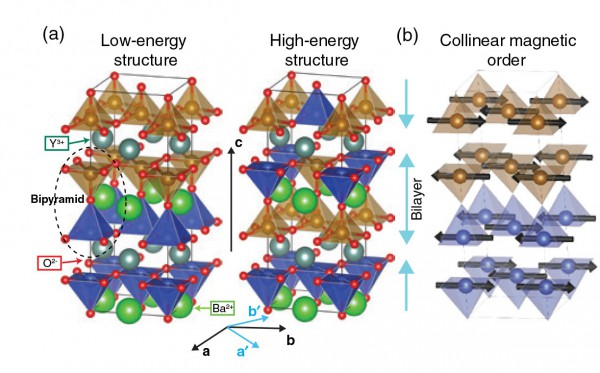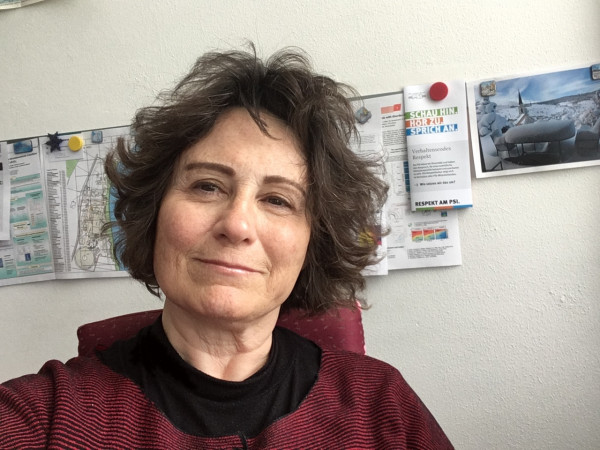Where magnetism and ferroelectricity meet: how MARVEL scientists found a very special multiferroic
by Nicola Nosengo, NCCR MARVEL
Research on multiferroics was already a success story in its own right in the mid 2010s. These rare materials that combine both a magnetic and a ferroelectric ordering, had been on the radar of materials scientists since the early 2000s, largely thanks to seminal work by the British scientist Nicola Spaldin when she was at the University of California.
Spaldin had applied electronics structure theory to investigate why materials that are ferromagnetic and ferroelectric in the same phase are so rare. She had identified a few key electronic properties a multiferroic should have, which eventually led to the experimental demonstration of the multiferroic properties of bismuth ferrite, BiFeO3. After that, interest in multiferroics spiked. Beyond theoretical aspects, what makes them so appealing is that their magnetisation can be manipulated by applying an electric field, and using them to store data would bring a dramatic increase in efficiency. Instead of using an electric current to generate a magnetic field and using that field to “write” data on a magnetic material, which is what we do now wasting quite a lot of energy in the process, we could skip the magnetic field and write data directly by applying an electric current field.
By the time MARVEL started in 2014, research on multiferroics was in full swing but questions still abounded, in particular on how to control their properties and use them in real-world applications. Tackling such questions required close collaboration between theorists and experimentalists, and a particularly successful one started between then MARVEL members Spaldin, who had moved to ETH Zurich in 2010, and Marisa Medarde, an experimentalist at the Paul Scherrer Institute.

The structure of the multiferroic materials YBaCuFeO5
“Multiferroics was a relatively new topic for me” recalls Medarde. “On the other hand, many of them are complex oxides, and I had worked on oxides since my own PhD, trying to understand the link between crystal structure and physical properties using neutrons and X-rays. But I had a PhD student who was interested in multiferroics, and they seemed a nice thing to investigate because the nature of the magnetic order is a key parameter for the existence of multiferroicity, and solving magnetic structures is one of my group’s specialties”.
Medarde and her team started a project on a material that looked particularly promising: the layered perovskite YBaCuFeO5. What made it interesting was the presence of a magnetic spiral, a peculiar ordering that allows magnetism and ferroelectricity to co-exist in a stable manner. Magnetic spirals normally appear only at extra cold temperatures, but this perovskite was an exception: its spiral stayed in place well above 100K.

Marisa Medarde
The first experiments by Medarde’s team brought more questions than answers, though. “Every time we prepared the sample, the critical temperature for the spiral changed” says Medarde. “This was weird compared to our previous experience with oxides. And why did the samples with larger chemical disorder have higher spiral ordering temperatures? Chemical disorder often has the opposite effect”. We were puzzled and could not find answers on our own”.
Medarde reached out to Spaldin and proposed a collaboration. Spaldin assigned the work to her then postdoc Andrea Scaramucci, and the two groups started having regular meetings. “It was the first time I had such a fluid and nice collaboration with a theoretician who was so interested in the experimental part” says Medarde. “Every time we met, our experiments gave them new ideas, which in turn helped us to design better experiments. It was really nice”.
The result of the collaboration, outlined in a series of papers between 2015 and 2024 (see references at the end of this article), was a full experimental charachterization and theoretical explanation of the magnetic spiral in YBaCuFeO5, and of the link between its thermal stability and the degree of chemical disorder in the material’s atomic structure. In the end, it turned out that the spiral can be stabilized up to temperatures of 100 degrees Celsius - which would make it reliable enough for commercial application – by manipulating the degree of chemical disorder in the sample, and that in turn can be done by precisely tuning the cooling rate at the manufacturing stage.

Nicola Spaldin
References
M. Morin, A. Scaramucci, M. Bartkowiak, E. Pomjakushina, G. Deng, D. Sheptyakov, L. Keller, J. Rodriguez-Carvajal, N. A. Spaldin, M. Kenzelmann, K. Conder, M. Medarde, “Incommensurate magnetic structure, Fe/Cu chemical disorder, and magnetic interactions in the high-temperature multiferroic YBaCuFeO5”, Physical Review B 91, 064408 (2015). doi: 10.1103/PhysRevB.91.064408
M. Morin, T. Shang, A. Scaramucci, M. Bartkowiak, E. Pomjakushina, G. Deng, D. Sheptyakov, L. Keller, J. Rodriguez-Carvajal, N. A. Spaldin, M. Kenzelmann, K. Conder, M. Medarde, “Tuning magnetic spirals beyond room temperature with chemical disorder”, Nature Communications 7, 13758 (2016). doi: 10.1038/ncomms13758
T. Shang, A. Scaramucci, M. Bartkowiak, E. Pomjakushina, G. Deng, D. Sheptyakov, L. Keller, J. Rodriguez-Carvajal, N. A. Spaldin, M. Kenzelmann, K. Conder, M. Medarde, “Design of magnetic spirals in layered perovskites: extending the stability range far beyond room temperature”, Science Advances 4, eaau6386 (2018). doi: 10.1126/sciadv.aau6386
A. Scaramucci, H. Shinaoka, M. Mostovoy, M. Müller, C. Mudry, M. Troyer, N. Spaldin, “Multiferroic Magnetic Spirals induced by random magnetic exchanges”, Physical Review X 8, 011005 (2018). doi: 10.1103/PhysRevX.8.011005
A. Scaramucci, H. Shinaoka, M. V. Mostovoy, R. Lin, C. Mudry, M. Müller, “Spiral order from orientationally correlated random bonds in classical XY models”, Physical Review Research 2, 013273 (2020). doi: 10.1103/PhysRevResearch.2.013273
E. Marelli, J. Lyu, M. Morin, M. Leménager, T. Shang, N. S. Yüzbasi, D. Aegerter, J. Huang, N. D. Daffé, A. H. Clark, D. Sheptyakov, T. Graule, M. Nachtegaal, E. Pomjakushina, T. J. Schmidt, M. Krack, E. Fabbri, M. Medarde, “Cobalt-free layered perovskites RBaCuFeO5+δ (R = 4f lanthanide) as electrocatalysts for the oxygen evolution reaction”, EES Catalysis 2, 335 (2024). doi: 10.1039/D3EY00142C
V. Porée, D. J. Gawryluk, T. Shang, J. A. Rodríguez-Velamazań, N. Casati, D. Sheptyakov, X. Torrelles, and M. Medarde, “YBa1-xSrxCuFeO5 layered perovskites: An attempt to explore the magnetic order beyond the paramagnetic-collinear-spiral triple point”, Physical Review B 110, 235156 (2024). doi: 10.1103/PhysRevB.110.235156
A. Romaguera and M. Medarde, “Room temperature magnetoelectric magnetic spirals by design”, Frontiers in Materials 11, 1448765 (2024). doi: 10.3389/fmats.2024.1448765
Low-volume newsletters, targeted to the scientific and industrial communities.
Subscribe to our newsletter